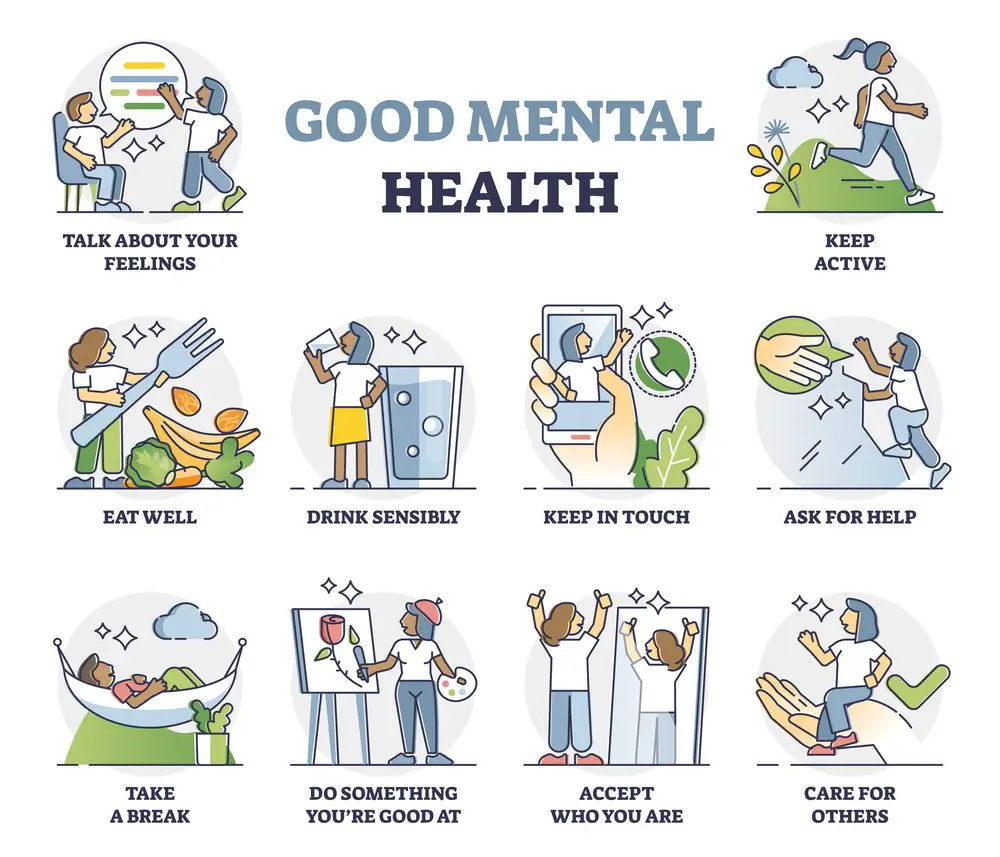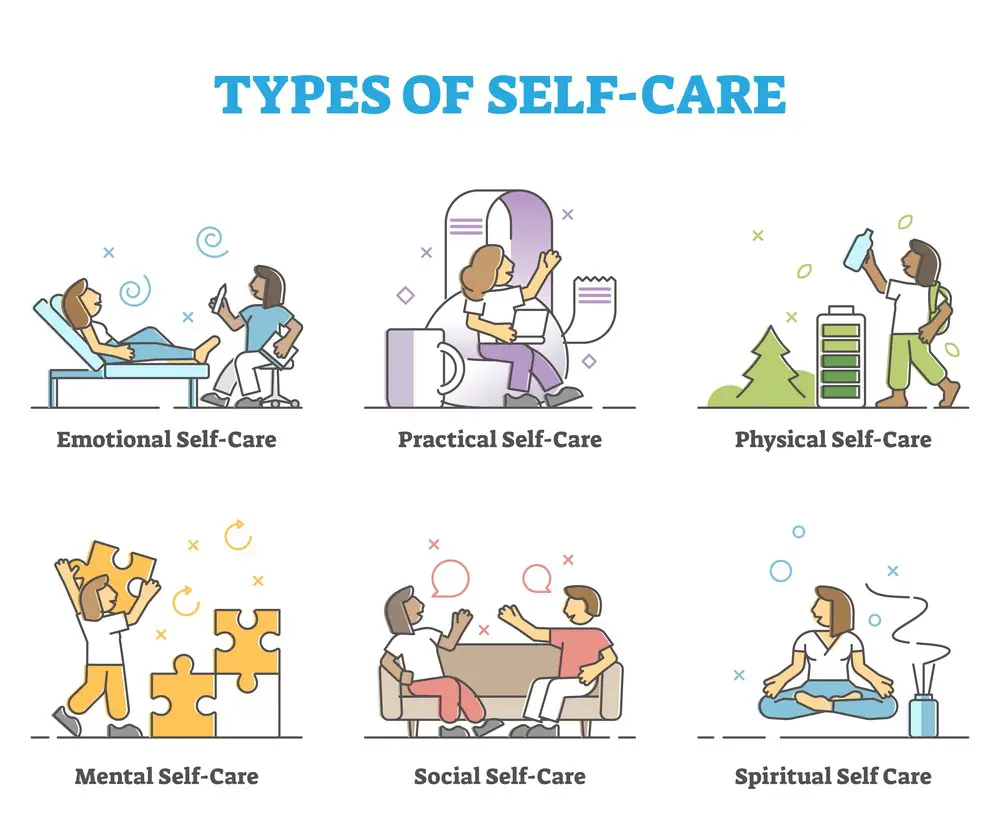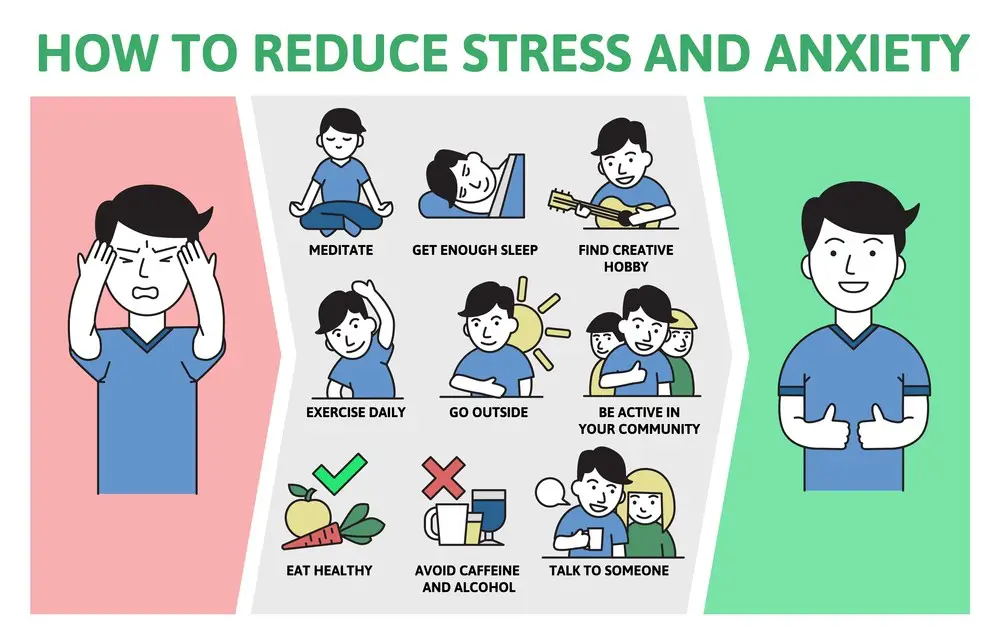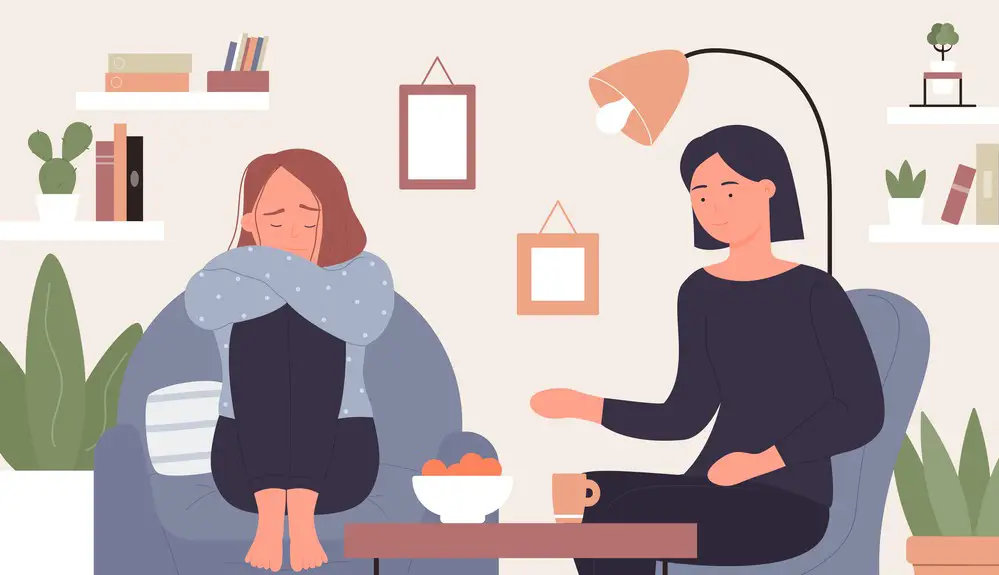As a BetterHelp affiliate, we receive compensation from BetterHelp if you purchase products or services through the links provided
Several factors contribute to the risk of suicide. These include individual risk factors like previous suicide attempts, a history of depression, serious illness, substance abuse, and financial problems. Other risk factors include relationship problems, challenging community issues, and societal risk.
Hundreds of thousands of people are affected by suicide worldwide. These people require expert help and support systems to help reduce the risk of suicide. However, you may not realize that several lifestyle choices can also make a difference.
1. Positive Habits for Suicide Prevention
If you are experiencing suicidal thoughts, there’s no need to feel like a failure or a weak person. But, when you have active suicidal thoughts, these require immediate action and long-term support.
Follow these positive habits to help you stay safe and for suicide prevention:
Reach out to someone you trust – The people who love you most often make the best listeners, offering emotional support and helping keep you safe while experiencing suicidal thoughts. If you don’t have someone you feel you can turn to, reach out to a crisis counselor who will lend a compassionate ear and guide you on reaching out for help.
Go to a safe location – Don’t stay home alone if you have suicidal thoughts. Go somewhere public or to a friend’s house. You must choose a space you feel comfortable visiting, even if it’s another room in your home.
Get rid of possible suicide methods – Anyone can have suicidal thoughts. Still, suppose you have actively thought of taking your life. You must remove any possible means of suicide, like weapons, medications, etc. If you are taking medications, you can ask someone to give you your correct dosage to prevent access to the medicine when you have suicidal thoughts.
Don’t drink alcohol or take other substances – Alcohol or drugs might appear to numb painful feelings you want to forget, but they can worsen depression and suicidal thoughts, so avoid taking them.
Use grounding techniques to reduce distress – Breathing exercises, taking a short walk, or cuddling your pet are some perfect examples of grounding techniques that will help you stay in the moment when feeling emotional distress. A crisis counselor can help you find the grounding technique that works best for you.
Calm your distress by doing something that relaxes you – Different people relax in different ways, so your relaxation techniques depend on your preferences. It could be listening to music, looking at photos, meeting a friend, or enjoying your favorite dessert.
 2. Building Resilience Through Lifestyle Choices
2. Building Resilience Through Lifestyle Choices
Studies show that resilience provides emotional strength to cope with hardships or trauma. People who build resilience feel less overwhelmed when met with challenges than those who lack it.
Everyday Health discusses the key factors that help build personal resilience provided by the American Psychological Association (APA). Resilience factors include family cohesion, positive self-outlook, and good social relations.
Others include social support, positive self-esteem, coping skills, communication, and emotions management.
Furthermore, the medical profession breaks down resilience into the following types: psychological, emotional, physical, and community. Healthier lifestyle choices can help you build the strength that enables you to function better and recover quicker when faced with challenges by increasing your stamina and strength.
Resilience can take time to build, requiring a combination of factors. There is also no hard-and-fast formula that you can use to build resilience. You must use external resources and inner strength to make yourself more resilient.
Making healthier lifestyle choices is a start to helping build the optimism required for emotional resilience, the strength needed for physical stability, and the necessary calmness to create psychological and community resilience.
 3. Enhancing Mental Wellbeing: Lifestyle Strategies
3. Enhancing Mental Wellbeing: Lifestyle Strategies
Mental well-being helps you to cope with life’s problems. Even people with mental health problems can cultivate mental wellbeing.
You can practice several things to take good care of your mental well-being. These include:
Reduce stress by relaxing – Relaxation can mean different things to different people, so find an activity that relaxes you and practice it daily. Relaxation means switching off, meaning that during that time, you must only concentrate on your activity choice, whether it’s watching something on TV, taking a walk, taking a break from work, having a relaxing bath, or listening to music. Try a breathing exercise routine or meditation if you have difficulty switching off, focusing on the present, or managing stress.
Learn something new or get creative – Add to your skillsets by joining a local or online class. If you prefer, take a creative learning course that aligns with your interests, like baking, photography, pottery, or drawing. The focus required to learn a new skill is excellent for ridding the mind of negative thoughts, and your reward is producing something that fills you with satisfaction.
Turn to nature – Spending time outdoors has several positive effects on mental well-being. When outdoors, practice mindfulness exercises. However, if you prefer being indoors, you can bring nature to your home by creating a lovely indoor garden or start bird-watching from your window. Animals are also known for their calming effect on people, so get a pet or try pet-sitting.
Connect with others – Whether you prefer to confide in someone you trust, speak to a mental health professional, or join a group of peers, it can help you maintain your mental well-being. It also helps to volunteer to help others through a charity organization. If you prefer not to join a charity, offer small acts of kindness in your community.
Look after your bodily health – Your physical health does affect your emotional well-being, so take care of yourself. Things to do is improve your sleep, keep active, avoid alcohol and drugs, drink plenty of water, follow a healthy diet, and take care of your appearance.
4. Promoting a Life Worth Living: Key Choices
Several critical lifestyle choices can help you promote a life worth living:
- Maintain a strong support network of friends and family
- Seek professional help
- Engage in regular exercise
- Get plentiful sleep and maintain a consistent sleep schedule
- Use relaxation techniques to reduce stress
- Limit alcohol and drug use
- Set reachable goals that you can realize in manageable steps
- Learn healthy coping strategies for when you have to deal with difficult emotions
- Stay connected with people and participate in social activities
- Reach out for help when experiencing suicidal thoughts or feeling overwhelmed
5. Lifestyle Factors That Lower Suicide Risk
There are several causes of suicidal thoughts, including underlying mental health conditions. Healthline states these include anxiety, post-traumatic stress disorder (PTSD), major depression, and substance use and eating disorders.
However, even people without these underlying conditions can experience suicidal thoughts. Statistics from the CDC indicate that 54% of people who died by suicide in 2018 were not diagnosed with any mental health conditions.
Therefore, other risk factors include genetics, significant challenges involving lifestyle challenges or stressors, isolation, bullying, chronic pain, and long-term health conditions.
Several lifestyle factors like diet, exercise, good sleep, and support from friends and family can lower the risk for most people with suicidal thoughts. Friends and family are vital in offering support. Contrary to myth, speaking to someone you are concerned about won’t increase their suicidal thoughts because bringing up the topic indicates you are willing to listen and support them.
6. Taking Control: Lifestyle Measures for Suicide Prevention
Protective measures like lifestyle and resilience are vital resources that can help minimize stressors, allowing you to overcome adversity.
The good news is that, like lifestyle, resilience is easy to learn because you can train yourself to reframe your thought patterns and tap into your strengths to overcome obstacles.
These are some of the steps you can take to build resilience, always remembering that it takes time to develop and you must work at maintaining it:
- Develop self-awareness by understanding how you typically respond to adversity, helping you learn adaptive strategies for your strengths and weaknesses.
- Build your self-regulation skills by learning to practice stress-reducing and focusing techniques. These include breathing exercises, guided imagery, and mindfulness to help you regulate your emotions, feelings, and behaviors.
- Learn coping skills that can help you deal with most challenges and stress. People prefer different coping skills, but many include lifestyle choices like exercising, improving sleep, and socializing. Other coping skills include journaling, finding a creative outlet, or reframing your thoughts.
- Build your optimism by focusing on how to face a challenge with positive problem-solving.
- Strengthen your support system to create resilience.
- Know your strengths and draw on them.

Transforming Lives: Lifestyle Choices for Mental Health
Lifestyle choices can improve mental health and transform your life because they can help reduce the risk of suicide. Include the following in your routine:
1. Regular Exercise
Exercise not only benefits your physical fitness but has a positive effect on your mental well-being. You require at least half an hour of moderate exercise daily to help release endorphins, the “feel-good” hormones that help fight melancholy, pressure, and tension, decreasing suicidal thoughts.
Ideal types of exercise include brisk walking, yoga, cycling, or swimming. Aim to exercise daily, but if you cannot manage, try incorporating it into your routine several days a week.
2. Create Human Connections
Maintaining proper mental health requires a supportive group of family or friends with whom you can share your thoughts. Ask them for assistance and support when you need help. Creating human connections is the best way to create a buffer between despair and isolation.
3. Maintain a Balanced Diet
Some foods, especially those that are sugary or processed, can cause your mood to fluctuate. Therefore, you want to maintain a nutritious and balanced diet to avoid the fluctuations that affect your mental well-being. Create your meals using lean proteins, grains, and leafy vegetables to give you resilience and emotional stability. Don’t forget to drink plenty of water to remain hydrated.
4. Get Enough Sleep
Sleep is vital for recharging your emotional and physical well-being. To combat feelings of distress or hopelessness, you need at least 7 to nine hours of sleep daily. You can achieve this by creating a calming bedtime routine.
 5. Adopt Stress-Relieving Tactics
5. Adopt Stress-Relieving Tactics
Managing stress levels is vital to your mental health and can reduce suicidal thoughts. Include an activity in your daily routine that can help you address life’s stressors. These activities could include meditation or deep breathing exercises. Still, it could also include something that brings you joy, like practicing yoga, playing a round of golf, or watching a sporting event.
6. Avoid Substance Use
Alcohol and drugs harm mental health. Alone or together, they can lead to suicidal thoughts. Alcohol consumption, even when limited, does pose a higher risk of cancer, but higher levels can increase your risk of high blood pressure, heart disease, strokes, and suicide. Therefore, avoid them alone or together to help protect your mental well-being and reduce the risk of suicide. Seek help from a mental health professional help if you are struggling with addiction to alcohol or other substances.
7. Find Professional Assistance
If you have suicidal thoughts, you must seek the help of a mental health specialist. Therapists and counselors have the training required to assist in navigating the stressful conditions that may lead to negative thoughts.
8. Safeguarding Against Suicide: Lifestyle Recommendations
Adopting the above lifestyle recommendations can help to reduce the risk of suicide. Investing in the proactive steps that prioritize your mental health and well-being can make you more resilient, giving you a more positive outlook and a happier life.
The most crucial lifestyle recommendations include regular exercise, having a supportive social network, adopting a healthier diet, and getting more and better quality sleep. Medical professionals and researchers also agree that limiting substance abuse plays a huge role in improving mental well-being.
Incorporate these lifestyle recommendations with all the mental health resources available to you, helping to reduce the risk of suicide even further. Besides mental health resources like seeing a certified therapist, there are several online therapy apps and counseling organizations where you can seek professional guidance.
 Red Flags on the Horizon: Recognizing When It’s Time for Professional Help
Red Flags on the Horizon: Recognizing When It’s Time for Professional Help
No Shame in the Game: Why Recognizing Red Flags is Essential
Life’s not always a smooth ride, and that’s okay. Struggling with mental health doesn’t make you weak; it makes you human. The real strength lies in acknowledging when you need help. Here, we’ll delve into the signs that it might be time to seek professional assistance.
Feeling the Weight: Chronic Sadness or Hopelessness
You’re not just having a bad day but a series of them. The weight on your shoulders feels like a boulder that’s too heavy to lift. If you’re persistently sad or experiencing a sense of hopelessness holding you hostage, it’s time to ask for help.
The Emotional Rollercoaster: Unpredictable Mood Swings
Emotions are a wild journey, aren’t they? One minute, you’re on top of the world; the next, you’re in a freefall. If your mood swings are erratic and affect your ability to function, consider that a red flag.
Retreat Mode: Social Isolation and Withdrawal
Have you started avoiding people like they’re spoilers to your favorite TV show’s season finale? It’s one thing to need “me time,” but it might indicate a deeper issue if you’re constantly ducking social interactions.
Breaking Point: Drastic Changes in Behavior or Appearance
Maybe you’ve quit caring about how you look, or you’ve swung the other way and obsessed over your appearance. Either way, drastic changes signify that you’re at a psychological intersection.
The Foggy Mirror: Signs of Detachment and Disassociation
Feeling disconnected from yourself or your environment is like walking through life wrapped in a thick fog. Take note if the world starts to feel unreal or like you’re observing yourself from outside your body.
Lost in a Maze: Persistent Confusion or Inability to Concentrate
If you can’t focus on tasks you used to complete easily or are struggling to make simple decisions, your mind might send you an SOS.
Body Talks: Unexplained Aches or Fatigue
Physical and mental health are two sides of the same coin. Unexplained aches, pains, or overwhelming fatigue could be your body telling you something’s not right upstairs.
The Sleep Saga: Changes in Sleep Patterns—Too Much or Too Little
Ah, sleep—the elusive dream! If you’re wrestling with insomnia or can’t seem to get out of bed, this could be more than a mere inconvenience; it’s a signal.
Playing with Fire: Risky Behavior and Substance Abuse
Are you pushing boundaries a bit too far? Taking unnecessary risks, especially with substances, is like playing with fire. And, as the saying goes, if you play with fire, you might get burned.
A Cry for Help: Verbal or Written Expressions of Suicidal Thoughts
This is the sign that should set off every alarm bell. If you or someone you know expresses suicidal thoughts, don’t wait. Seek professional help immediately.
The Fading Picture: Strained Personal Relationships
If people around you notice changes in your behavior and show concern, listen. They see you that you might not see.
Disconnection Alert: Lack of Interest in Activities Once Enjoyed
When joy is stripped from activities that used to make you happy, it’s a significant warning that your emotional well-being is off-balance.
Don’t Wait for the Storm to Pass: The Urgency of Seeking Professional Help
Don’t wait for a better day if any of these red flags resonate with you. Take action now. Therapy is not a sign of weakness; it’s a step towards reclaiming your life.
Remember, you don’t have to weather the storm alone. Reach out, speak up, and take the steps to get back to a better you.
 Charting Your Course: Setting Goals and Monitoring Progress in Therapy
Charting Your Course: Setting Goals and Monitoring Progress in Therapy
Why Goals Matter: The Roadmap to Recovery
In the wilderness of mental health, think of therapy as your GPS. It’s easier to reach your destination with clear, well-defined goals. Goals provide a direction and a measurable way to see how far you’ve come.
 SMART Goals: Specific, Measurable, Achievable, Relevant, Time-bound
SMART Goals: Specific, Measurable, Achievable, Relevant, Time-bound
Remember that not all goals are created equal. The more specific you can be, the better. Here’s a quick guide to setting SMART goals:
- Specific: What exactly do you want to achieve?
- Measurable: How will you know you’ve reached your goal?
- Achievable: Is this goal realistic, given your current circumstances?
- Relevant: Does this goal align with your broader life objectives?
- Time-bound: When do you aim to achieve this goal?
The Progress Journal: Your Logbook
Jot down your thoughts, feelings, and milestones in a dedicated journal. Think of it as a personal logbook where you record your therapy journey. Here are some ideas for what to include:
- Insights Gained: What new things have you learned about yourself?
- Challenges Faced: What obstacles have come your way, and how have you dealt with them?
- Victories, Big or Small: Did you attend a social gathering? Sleep well for a night? Celebrate those wins!
 The Check-In: Regularly Assessing Progress with Your Therapist
The Check-In: Regularly Assessing Progress with Your Therapist
Think of this as your pit stop in the journey. Regular check-ins with your therapist can provide valuable feedback and help adjust your course as needed. During these sessions, consider the following:
- Are you closer to your goals?
- Have any circumstances changed that require adjustments to your goals?
- Is the current therapeutic approach working, or is it time to try something new?
Tracking Tools: Apps and Gadgets that Can Help
Plenty of resources are out there to help you stay on top of your progress. Some people find mood-tracking apps or wearable health gadgets helpful in monitoring stress levels, sleep quality, and other relevant metrics.
Pivot or Proceed: Making Informed Decisions
If you find that you’re not making the progress you’d hoped for, it’s okay. Therapy is not a straight path, and it’s completely fine to reassess and pivot if needed. You might explore different therapeutic methods or consider supplemental treatments, like medication or group therapy.
Celebrate the Milestones: Acknowledge Your Progress
Remember that therapy is a journey, not a sprint. Celebrate your progress, however small it may seem. Whether feeling a little brighter, handling stress better, or improving your relationships, every step forward is worth acknowledging.
The Future Focus: Preparing for Life Post-Therapy
As you make progress, start thinking about your post-therapy life. How will you maintain your gains? What coping skills have you acquired? Plan for the long term while relishing the progress you’re making now.
Setting goals and monitoring progress are integral parts of the therapeutic process. They’re your co-pilots, helping you navigate the twists and turns on your road to better mental health. Take the wheel, set your course, and don’t forget to enjoy the journey.
About Jacob Maslow
After surviving the traumatizing events of 9/11, I took it upon myself to heal through helping others. I’m the primary caregiver of my children and understand from first-hand experience the lonely paths you have to walk as a partner and parent when leaving an unhealthy relationship.
We’re all echoing in a dark space that doesn’t have to be this empty, and that’s been my mission since finding solace and recovery in therapy: To help comfort others who are still in shock and at the prime of their struggle.
I came across BetterHelp after searching for this type of community. I wanted to belong to a body of proactive therapists and supportive therapy veterans that allowed me to see other sides of the story.
It was unconventional, and that’s what attracted me most. During my most challenging times, when my ex-wife completely cut me off from my children, I found comfort and clarity through BetterHelp.
Instead of being chained to a strict therapist recommendation, I was in charge of who I felt understood my struggle most. That allowed me to find my true peace, as I was reunited with those who read behind my words and had first-hand experience with my trauma.
Recovery is a choice; with BetterHelp, that choice will be a few clicks away. You can join their couples-oriented platform, Regain.us for those stuck with family estrangement and toxic relationship patterns.
This site contains affiliate links to products. We will receive a commission for purchases made through these links.


 2. Building Resilience Through Lifestyle Choices
2. Building Resilience Through Lifestyle Choices 3. Enhancing Mental Wellbeing: Lifestyle Strategies
3. Enhancing Mental Wellbeing: Lifestyle Strategies 5. Adopt Stress-Relieving Tactics
5. Adopt Stress-Relieving Tactics Red Flags on the Horizon: Recognizing When It’s Time for Professional Help
Red Flags on the Horizon: Recognizing When It’s Time for Professional Help Charting Your Course: Setting Goals and Monitoring Progress in Therapy
Charting Your Course: Setting Goals and Monitoring Progress in Therapy SMART Goals: Specific, Measurable, Achievable, Relevant, Time-bound
SMART Goals: Specific, Measurable, Achievable, Relevant, Time-bound The Check-In: Regularly Assessing Progress with Your Therapist
The Check-In: Regularly Assessing Progress with Your Therapist
